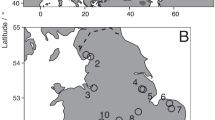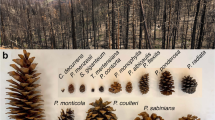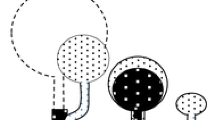Abstract
Long-lived understory herbs experience a highly dynamic forest over space and time, yet can persist for more than a century. To understand how these populations persist, we examined effects of forest age and disturbance on potential sexual reproduction and clonal growth in the sexually labile perennial, Arisaema triphyllum. Potential sexual reproduction (female:male ratio) was significantly greater in the Young and Old-Gap forest states compared with Old, closed-canopy sites, where it was virtually absent. In contrast, clonal growth (estimated by cormlet production) did not differ significantly among the three forest states. Of seven environmental variables measured, only light (positively) and plant density (negatively) contributed significantly to the variation in potential sexual reproduction, while no measured variables contributed significantly to the variation in number of cormlets. The larger sexual reproductive effort (flower+stalk biomass/total biomass) for males in the undisturbed, 100 yr old forest may explain the absence of females in these sites, while the invariant vegetative reproductive effort (cormlet biomass/total biomass) may explain the similarity in average number of cormlets per individual per season across forest states. These results suggest that potential sexual reproduction is resource-limited, while clonal growth may be resource-independent. By maintaining ramet production during unfavorable periods, A. triphyllum populations disperse temporally, “waiting” for conditions under which sexual reproduction may resume.
Similar content being viewed by others
References
Anderson M.C. 1964. Studies of the woodland light climate. II. Seasonal variation in the light climate. Journal of Ecology 52: 643-663.
Abrahamson W.G. 1975. Reproductive strategies in dewberries. Ecology 56: 721-726.
Barkham J.P. and Hance C.E. 1982. Population dynamics of the wild daffodil (Narcissus peudonarcissus) III. Implications of a computer model of 1000 years of population change. Journal of Ecology 70: 323-344.
Bell A.D. and Tomlinson P.B. 1980. Adaptive architecture in rhizomatous plants. Botanical Journal of the Linnean Society 80:125–160.
Bierzychudek P. 1982. The demography of Jack-in-the-Pulpit, a forest perennial that changes sex. Ecological Monographs 52: 335-351.
Bierzychudek P. 1984. Determinants of gender in Jack-in-the-Pulpit: the influence of plant size and reproductive history. Oecologia 65: 14-18.
Brown M.J. and Parker G.G. 1994. Penetration of photosynthetically active radiation in a chronosequence of mixed species forests. Canadian Journal of Forest Research 24: 1694-1703.
Cain M.L. and Damman H. 1997. Clonal growth and ramet performance in the woodland herb, Asarum canadense. Journal of Ecology 85: 883-897.
Cheplick G.P. 1995. Life history trade-offs in Amphibromus scabrivalvis (Poaceae): Allocation to clonal growth, storage, and cleistogamous reproduction. American Journal of Botany 82: 621-629.
Cohen D. 1966. Optimizing reproduction in a randomly varying environment. Journal of Theoretical Biology 12: 119-129.
Cook R.E. 1979. Asexual reproduction: a further consideration. American Naturalist. 113: 769-772.
Eriksson O. and Kiviniemi K. 1999. Evolution of Plant Dispersal. pp. 216–238. In: Vuorisalo T.O. and Mutikainen P.K. Eds., Life History Evolution in Plants. Kluwer Academic Publishers, Dordrecht, The Netherlands.
Feller I.C., Kudoh H., Tanner C.E. and Whigham D.F. 2003. Sexbiased herbivory in Jack-in the Pulpit (Arisaema triphyllum) by a specialist thrips (Heterothrips arisaemae). Proceedings of the 7th Annual Symposium on Thysanoptera. Reggio Calabria, Italy. in press.
Gadgil M.D. and Solbrig O.T. 1972. The concept of r-and K-selection: evidence from wild flowers and some theoretical consideration. American Naturalist. 106: 14-31.
Grime J.P. 1979. Plant Strategies and Vegetation Processes. John Wiley, New York.
Harper J.L. 1977. Population Biology of Plants. Academic Press, London.
Hartnett D.C. 1990. Size-dependent allocation to sexual and vegetative reproduction in four clonal composites. Oecologia 84: 254-259.
Hairston Jr. N.G., Ellner S. and Kearns C.M. 1996. Overlapping generations: the storage effect and the maintenance of biotic diversity. pp. 109–145. In: Rhodes Jr. O.E., Chesser R.K. and Smith M.H. (Eds.), Population dynamics in ecological space and time. University of Chicago Press, Chicago, IL.
Hemiview 2., 1 Delta-T Devices Ltd. Cambridge, UK
Holler L.C. and Abrahamson W.G. 1977. Seed and vegetative reproduction in relation to density in Fragaria virginiana (Rosaceae). American Journal of Botany 64: 1003–1007.
Hughes J.W., Fahey T.J. and Bormann F.H. 1988. Population persistence and reproductive ecology of a forest herb: Aster acuminatus. American Journal of Botany 75: 1057-1064.
Hurst L.D. and Peck J.R. 1996. Recent advances in understanding of the evolution and maintenance of sex. Trends in Ecology and Evolution 11: 46-52.
Kalisz S. 1986. Variable selection on thetiming of germination in Collinsia verna (Scrophulariaceae). Evolution 40: 479-491.
Kudoh H., Shibaike H., Takasu H., Whigham D. and Kawano S. 1999. Genet structure and determinants of clonal structure in a temperate deciduous woodland herb, Uvularia perfoliata. Journal of Ecology 87: 244-257.
Lovett-Doust J. and Cavers P.B. 1982. Sex and gender dynamics in Jack-in-the-Pulpit, Arisaema triphyllum (Araceae). Ecology 63(3): 797-808.
MacArthur R.H. and Wilson E.O. 1967. The Theory of Island Biogeography. Princeton University Press Princeton, New Jersey. 203 pp.
Menges E.S. 1990. Environmental correlations with male, female, and clonal biomass allocation in the forest herb, Laportea canadensis. Amerian Midland Naturalist 124: 171-180.
Newel S.J. and Tramer E.J. 1978. Reproductive strategies in herbaceous plant communities during succession. Ecology 59: 228-234.
Nishitani S. and Kimura M. 1993. Resource allocation to sexual and vegetative reproduction in a forest herb Syneilesis palmata (Compositae). Ecological Research 8: 173-183.
Piquot Y., Petit D., Valero M., Cuguen J., Laguerie P. and Vernet P. 1998. Variation in sexual and asexual reproduction among young and old populations of the perennial macrophyte, Sparganium erectum. Oikos: 82: 139-148.
Pitelka L.F., Stanton D.S. and Peckenham M.O. 1980. Effects of light and density on resource allocation in a forest herb, Aster acuminatus (Compositae). American Journal of Botany 67: 948-942.
Pornon A., Escaravage N., Till-Bottraud I. and Doche B. 1997. Variation of reproductive traits in Rhododendron ferrugineum (Ericaceae) populations along a successional forest gradient. Plant Ecology 130: 1-11.
Rust R.W. 1980. Pollen movement and reproduction in Arisaema triphyllum. Bulletin of the Torrey Botanical Club 107: 539-542.
Silander 1985. Microevolution in clonal plants. In: Population biology and evolution of clonal organisms, pp. 107-152. In: Jackson J.B.C., Bliss L.W. and Cook R.E. (Eds.), Population biology and evolution of clonal organisms. Yale University Press, New Haven.
Sun S., Gao X. and Cai Y. 2001. Variations in sexual and asexual reproduction of Scirpus mariqueter along an elevational gradient. Ecological Research 16: 263-274.
Tamm C.O. 1948. Observations on reproduction and survival of some perennial herbs. Botaniska Notiser 3:305-321.
Thompson J.N. and Willson M.F. 1978. Disturbance and the dispersal of fleshy fruits. Science 200: 1161-1163.
Tonsor S.J., Kalisz S., Fisher J. and Holtsford T.P. 1993. A life-history based study of population genetic structure: Seed bank to adult in Plantago lanceolata. Evolution 47: 833-843.
Treiber M. 1980. Biosystematics of the Arisaema triphyllum complex. PhD Dissertation, University of North Carolina, Chapel Hill.
Whigham D. 1974. An ecological life history study of Uvularia perfoliata L. American Midland Naturalist 91:343:359.
Wijesinghe D.K. and Whigham D.F. 1997. Cost of producing clonal offspring and the effects of plant size on population dynamics of the woodland herb Uvularia perfoliata I. Journal of Ecology 85: 907-919.
Yang J., Lovett-Doust J. and Lovett-Doust L. 1999. Seed germination patterns in green dragon (Arisaema dracontium, Araceae). American Journal of Botany 86: 1160-1167.
Author information
Authors and Affiliations
Rights and permissions
About this article
Cite this article
Levine, M.T., Feller, I.C. Effects of forest age and disturbance on population persistence in the understory herb, Arisaema triphyllum (Araceae). Plant Ecology 172, 73–82 (2004). https://doi.org/10.1023/B:VEGE.0000026036.32013.7a
Issue Date:
DOI: https://doi.org/10.1023/B:VEGE.0000026036.32013.7a




